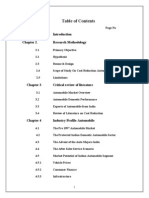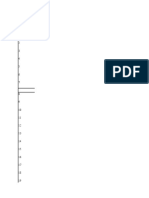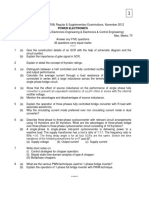GMC Case Study
GMC Case Study
Uploaded by
Anish SinghCopyright:
Available Formats
GMC Case Study
GMC Case Study
Uploaded by
Anish SinghOriginal Title
Copyright
Available Formats
Share this document
Did you find this document useful?
Is this content inappropriate?
Copyright:
Available Formats
GMC Case Study
GMC Case Study
Uploaded by
Anish SinghCopyright:
Available Formats
Giant Motor Company I
1
This problem deals with strategic planning issues for a large company.
The main issue is planning the company's production capacity for the
coming year. At issue is the overall level of capacity and the type of
capacity for e!ample" the degree of fexibility in the manufacturing
system. The main tool used to aid the company's planning process in
GMC I is a mi!ed integer programming #MI$% model. A mi!ed integer
program has both integer and continuous variables.
&
$roblem 'tatement
The Giant Motor Company #GMC% produces three lines of cars for the
domestic #(.'.% mar)et* +yras" +ibras" and ,ydras. The +yra is a
relatively ine!pensive subcompact car that appeals mainly to -rst.time
car owners and to households using it as a second car for commuting.
The +ibra is a sporty compact car that is slee)er" faster" and roomier
than the +yra. /ithout any options" the +ibra costs slightly more than
the +yra0 additional options increase the price further. The ,ydra is the
lu!ury car of the GMC line. It is signi-cantly more e!pensive than the
+yra and +ibra" and it has the highest pro-t margin of the three cars.
1etooling 2ptions for Capacity 3!pansion
Currently GMC has three manufacturing plants in the (nited 'tates.
3ach plant is dedicated to producing a single line of cars. In its
planning for the coming year" GMC is considering the retooling of its
+yra and4or +ibra plants. 1etooling either plant would represent a ma5or
e!pense for the company. The retooled plants would have signi-cantly
increased production capacities. Although having greater fxed costs"
the retooled plants would be more e6cient and have lower marginal
production costs that is" higher marginal pro-t contributions.
In addition" the retooled plants would be fexible they would have
the capability of producing more than one line of cars.
1
7rom $ractical Management 'cience #&nd ed." /inston and Albright" &881 9u!bury
$ress" pp. ::;.::<%.
2
A continuation of this problem" GMC II #at the end of Chapter 18 in /inston and
Albright%" deals with capacity planning in a multi.period" multi.scenario framewor). In
GMC II the MI$ model is e!tended to handle the multi.period stochastic nature of the
problem.
The characteristics of the current plants and the retooled plants are
given in Table 1. The retooled +yra and +ibra plants are prefaced by the
word new. The -!ed costs and capacities in Table 1 are given on an
annual basis. A dash in the pro-t margin section indicates that the
plant cannot manufacture that line of car. 7or e!ample" the new +yra
plant would be capable of producing both +yras and +ibras but not
,ydras. The new +ibra plant would be capable of producing any of the
three lines of cars. =ote" however" that the new +ibra plant has a
slightly lower pro-t margin for producing ,ydras than the ,ydra plant.
The >e!ible new +ibra plant is capable of producing the lu!ury ,ydra
model" but is not ?uite as e6cient as the current ,ydra plant that is
dedicated to ,ydra production.
The -!ed costs are annual costs that are incurred by GMC independent
of the number of cars that are produced by the plant. 7or the current
plant con-gurations" the -!ed costs include property ta!es" insurance"
payments on the loan that was ta)en out to construct the plant" and so
on. If a plant is retooled" the -!ed costs will include the previous -!ed
costs plus the additional cost of the renovation. The additional
renovation cost will be an annual cost representing the cost of the
renovation amorti@ed over a long period.
9emand for GMC Cars
'hort.term demand forecasts have been very reliable in the past and
are e!pected to be reliable in the future. The demand for GMC cars for
the coming year is given in Table &.
A ?uic) comparison of plant capacities and demands in Tables 1 and &
indicates that GMC is faced with insu6cient capacity. $artially
oAsetting the lac) of capacity is the phenomenon of demand
diversion. If a potential car buyer wal)s into a GMC dealer showroom
wanting to buy a +yra but the dealer is out of stoc)" fre?uently the
salesperson can convince the customer to purchase the better +ibra
car" which is in stoc). (nsatis-ed demand for the +yra is said to be
diverted to the +ibra. 2nly rarely in this situation can the salesperson
convince the customer to switch to the lu!ury ,ydra model.
7rom past e!perience" GMC estimates that :8B of unsatis-ed demand
for +yras is diverted to demand for +ibras and <B to demand for
,ydras. 'imilarly" 18B of unsatis-ed demand for +ibras is diverted to
demand for ,ydras. 7or e!ample" if the demand for +yras is 1";88"888
cars" then the unsatis-ed demand will be ;88"888 if no capacity is
added. 2ut of this unsatis-ed demand" 1&8"888 #C;88"888 ! 8.:% will
materiali@e as demand for +ibras" and &8"888 #C;88"888 ! 8.8<% will
materiali@e as demand for ,ydras. 'imilarly" if the demand for +ibras is
1"&&8"888 cars #1"188"888 original demand plus 1&8"888 demand
diverted from +yras%" then the unsatis-ed demand for +ibras would be
DE8.&:<8 & $rof. Furan
;&8"888 if no capacity is added. 2ut of this unsatis-ed demand" ;&"888
#C;&8"888 ! 8.1% will materiali@e as demand for ,ydras. All other
unsatis-ed demand is lost to competitors. The pattern of demand
diversion is summari@ed in Table :.
Lyra Libra Hydra
New
Lyra
New
Libra
Capacity #in 1888s% 1888 G88 H88 1E88 1G88
7i!ed cost #in
Imillions% &888 &888 &E88 :;88 :J88
Proft Margin by Car Line (in $1000s)
+yra & . . &.< &.:
+ibra . : . :.8 :.<
,ydra . . < . ;.G
Table 1* $lant Characteristics
Demand (in
1000s)
+yra 1;88
+ibra 1188
,ydra G88
Table &* 9emand for GMC Cars
Lyra Libra Hydra
+yra =A 8.: 8.8<
+ibra 8 =A 8.18
,ydra 8 8 =A
Table :* 9emand 9iversion Matri!
Kuestion
GMC wants to decide whether to retool the +yra and +ibra plants. In
addition" GMC wants to determine its production plan at each plant in
the coming year. Dased on the previous data" formulate a mi!ed
integer programming model for solving GMC's production planning.
capacity e!pansion problem for the coming year.
:
3
Ac)nowledgment* The idea for GMC I and II came from 3ppen et al #1HGH%.
DE8.&:<8 : $rof. Furan
You might also like
- Anand Mahindra Leadership StyleDocument27 pagesAnand Mahindra Leadership StyleAbhishekVairale86% (7)
- LS Swaps: How to Swap GM LS Engines into Almost AnythingFrom EverandLS Swaps: How to Swap GM LS Engines into Almost AnythingRating: 3.5 out of 5 stars3.5/5 (2)
- CASE ABI Stanhope Ver2Document9 pagesCASE ABI Stanhope Ver2rahul100% (1)
- PMO Maturity AssessmentDocument3 pagesPMO Maturity AssessmentPMI South Florida ChapterNo ratings yet
- Case Study 8.6: Transformation in The Automobile IndustryDocument4 pagesCase Study 8.6: Transformation in The Automobile IndustryUmar100% (1)
- GM Business PlanDocument6 pagesGM Business PlanPriyanka NemaNo ratings yet
- How to Supercharge & Turbocharge GM LS-Series Engines - Revised EditionFrom EverandHow to Supercharge & Turbocharge GM LS-Series Engines - Revised EditionRating: 5 out of 5 stars5/5 (3)
- Station Fuel Self Audit Checklist and Instructions - Envoy AirDocument13 pagesStation Fuel Self Audit Checklist and Instructions - Envoy AirTrong Tuan NguyenNo ratings yet
- As 1121.4-2007 Agricultural Tractor Power Take-Offs Guards For Power Take-Off (PTO) Drive-Shafts - Strength ADocument8 pagesAs 1121.4-2007 Agricultural Tractor Power Take-Offs Guards For Power Take-Off (PTO) Drive-Shafts - Strength ASAI Global - APACNo ratings yet
- Case 3 Auto AssemblyDocument3 pagesCase 3 Auto Assemblyuzumakhinaruto100% (1)
- SWOT Analysis of BMWDocument4 pagesSWOT Analysis of BMWPhoenixNo ratings yet
- Tesla Q1 2019 LetterDocument10 pagesTesla Q1 2019 LetterFred LamertNo ratings yet
- TSLA Update Letter 2018-2QDocument10 pagesTSLA Update Letter 2018-2QFred LamertNo ratings yet
- Shapiro CHAPTER 3 Altered SolutionsDocument17 pagesShapiro CHAPTER 3 Altered Solutionsjimmy_chou1314100% (1)
- MGMT 3060 Final Exam - Fall 2020Document3 pagesMGMT 3060 Final Exam - Fall 2020zaid nazalNo ratings yet
- American "Big 3" Manufacturers: Improvements in DesignDocument2 pagesAmerican "Big 3" Manufacturers: Improvements in Designruchi0070No ratings yet
- 2019 Annual Shareholder Meeting PresentationDocument20 pages2019 Annual Shareholder Meeting PresentationMáté VanyekNo ratings yet
- Tesla Motors in 2023 1Document11 pagesTesla Motors in 2023 1Achmed AlwanNo ratings yet
- Dominion Motors LTDDocument5 pagesDominion Motors LTDutkarshdave100% (1)
- Cost Reduction Techniques FinalDocument89 pagesCost Reduction Techniques FinalJaspreet SinghNo ratings yet
- Econ IaDocument36 pagesEcon IaJayquanKush Kush Dougie75% (4)
- Proton Mm-CombinedDocument41 pagesProton Mm-CombinedNurLiyanaNo ratings yet
- Analysis of GMDocument10 pagesAnalysis of GMMichael JonesNo ratings yet
- Revision Progress Test 1 - Investment AppraisalDocument5 pagesRevision Progress Test 1 - Investment Appraisalsamuel_dwumfourNo ratings yet
- An Empirical Study On Supply Chain Inventory Management in The Auto Component IndustryDocument62 pagesAn Empirical Study On Supply Chain Inventory Management in The Auto Component IndustryArchie SrivastavaNo ratings yet
- GMBA 608: Management Information Systems: Dr. Richard Boateng - Chapter 3 Case StudyDocument4 pagesGMBA 608: Management Information Systems: Dr. Richard Boateng - Chapter 3 Case StudyHenry PK ZEeNo ratings yet
- Sai Charan Perugu Dominion Case AnalysisDocument5 pagesSai Charan Perugu Dominion Case AnalysismmsrajuNo ratings yet
- Reading Assignment 2Document3 pagesReading Assignment 2Ninuca KalandarishviliNo ratings yet
- Finance Project On Working Capital Management in BirlaDocument64 pagesFinance Project On Working Capital Management in BirlaDavinderSinghNo ratings yet
- Hero Honda Splender ProDocument91 pagesHero Honda Splender ProSubramanya Dg100% (1)
- IGCSE Economics Self Assessment Chapter 21 AnswersDocument3 pagesIGCSE Economics Self Assessment Chapter 21 AnswersDesreNo ratings yet
- Dissertation On Hybrid VehiclesDocument6 pagesDissertation On Hybrid VehiclesBestWriteMyPaperWebsiteUK100% (1)
- Automobile Industry in IndiaDocument2 pagesAutomobile Industry in IndiaKannan KarunakaranNo ratings yet
- 1 BCG:汽车商业模式报告-如何在未来的汽车和出行行业中获利Document12 pages1 BCG:汽车商业模式报告-如何在未来的汽车和出行行业中获利zhang moyaNo ratings yet
- Amaron Battery Project ReportDocument52 pagesAmaron Battery Project Reportraj_vardhan0020% (5)
- Transparency Market ResearchDocument11 pagesTransparency Market Researchapi-259683748No ratings yet
- DCF Group 5Document18 pagesDCF Group 5Ravi Kumar100% (1)
- E-Vehicles Battery NeedDocument4 pagesE-Vehicles Battery Needhan18No ratings yet
- MGT330 Report Brief Descrition To Analysis of Demand ForecastingDocument3 pagesMGT330 Report Brief Descrition To Analysis of Demand Forecastingseraphine2031038No ratings yet
- Automobile: Each Detailed Project Reports Cover All The Aspects of Business, From Analysing TheDocument8 pagesAutomobile: Each Detailed Project Reports Cover All The Aspects of Business, From Analysing Themgd5697No ratings yet
- Global OEM Parts SupplierDocument1 pageGlobal OEM Parts SupplierReshma GhadiNo ratings yet
- Hero Honda Motorcycle ProjectDocument93 pagesHero Honda Motorcycle ProjectSharath HegdeNo ratings yet
- Cap Bud CaseDocument3 pagesCap Bud CasePinal ShahNo ratings yet
- Corpfinance AmchemDocument12 pagesCorpfinance AmchemSuyash JoshiNo ratings yet
- Old Case SummariesDocument21 pagesOld Case SummariesShewanti ShendeNo ratings yet
- Car and Truck GuideDocument114 pagesCar and Truck GuideClinicalanalyzer SpecialistincNo ratings yet
- SWOT Analysis - GigacastingDocument10 pagesSWOT Analysis - GigacastingBrian OmondiNo ratings yet
- Ryerson University Department of Economics ECN 204 Midterm Winter 2013Document22 pagesRyerson University Department of Economics ECN 204 Midterm Winter 2013creepyslimeNo ratings yet
- Hybrid Car ThesisDocument7 pagesHybrid Car Thesisfc2frpq5100% (2)
- Final Project Report of ManjuDocument20 pagesFinal Project Report of ManjuBASIL GEORGENo ratings yet
- Capital Budgeting 2Document3 pagesCapital Budgeting 2mlexarNo ratings yet
- LongIdea GMUpdate 2021 2 17-1Document9 pagesLongIdea GMUpdate 2021 2 17-1PeterNo ratings yet
- Corpfinance AmchemDocument11 pagesCorpfinance AmchemSantanu DasNo ratings yet
- A Project Report On Exide BatteryDocument72 pagesA Project Report On Exide BatterySourav Roy75% (4)
- A1 - Can The Automotive Industry Scale Fast Enough PDFDocument7 pagesA1 - Can The Automotive Industry Scale Fast Enough PDFSHUN (경영전문대학원 경영(Global MBA)) KAJITANo ratings yet
- A Project Report On Exide BatteryDocument73 pagesA Project Report On Exide BatterySourav RoyNo ratings yet
- Strategic Management ProjectDocument20 pagesStrategic Management ProjectMoustafa MagdyNo ratings yet
- Factors That Affect The Price of Electric Car Conversions 205086Document2 pagesFactors That Affect The Price of Electric Car Conversions 205086nguyenthik.hanhhuye.n.5.7031gNo ratings yet
- IBM Final Dow 30 - UneditedDocument12 pagesIBM Final Dow 30 - UneditedVeronica JacksonNo ratings yet
- Xfer Case IdentificationDocument9 pagesXfer Case IdentificationErickMaki0% (1)
- Cars And Auto Accessories: The Little Gadgets That Personalise Luxury...From EverandCars And Auto Accessories: The Little Gadgets That Personalise Luxury...No ratings yet
- BC517Document8 pagesBC517TURBOJATONo ratings yet
- RTG 05 Hoist Wire Rope DamageDocument3 pagesRTG 05 Hoist Wire Rope DamageMohammed AtefNo ratings yet
- Qcs 2010 Section 21 Part 2 MV Factory Built Assemblies (FBA's)Document22 pagesQcs 2010 Section 21 Part 2 MV Factory Built Assemblies (FBA's)bryanpastor106100% (1)
- Space Tourism: The Commercialisation of SpaceDocument1 pageSpace Tourism: The Commercialisation of SpaceLaura BernabéNo ratings yet
- Rotomolding Manholes - 2333Document20 pagesRotomolding Manholes - 2333mujeebscribdNo ratings yet
- How To Convert To DGCADocument3 pagesHow To Convert To DGCASathya RubanNo ratings yet
- Sample Estimate - 2 Bedroom Hall Kitchen: Item NoDocument15 pagesSample Estimate - 2 Bedroom Hall Kitchen: Item NoAditya AnandNo ratings yet
- Kapci HardenersDocument3 pagesKapci HardenersMohamed AdelNo ratings yet
- RLX Incident Costing Model1Document34 pagesRLX Incident Costing Model1Abdulhmeed MutalatNo ratings yet
- Vintage Airplane - Dec 1988Document32 pagesVintage Airplane - Dec 1988Aviation/Space History LibraryNo ratings yet
- Group 3 RDocument196 pagesGroup 3 RnumanNo ratings yet
- Introduction To Operations Management: Mcgraw-Hill/IrwinDocument43 pagesIntroduction To Operations Management: Mcgraw-Hill/Irwinvasusingla100% (1)
- Aviation Courses After 12thDocument3 pagesAviation Courses After 12thAmjad PathanNo ratings yet
- Auto Mat Is MeDocument58 pagesAuto Mat Is MeBouallegue Mounir100% (1)
- I Jcs It 2015060294Document4 pagesI Jcs It 2015060294Garima JhadeNo ratings yet
- Basic Config For Distributed DataDocument8 pagesBasic Config For Distributed DataRam KLNo ratings yet
- 9A02504 Power ElectronicsDocument4 pages9A02504 Power ElectronicsMohan Krishna100% (1)
- Bohler Welding Thermalpower - ENGDocument24 pagesBohler Welding Thermalpower - ENGghostinshellNo ratings yet
- PMS Conoco PhilipsDocument2 pagesPMS Conoco PhilipsManjunatha VNo ratings yet
- Grade Markings For Steel Bolts and ScrewsDocument3 pagesGrade Markings For Steel Bolts and Screwsrexie2canos8964No ratings yet
- My Mgt613 Quiz 5 by SobanDocument10 pagesMy Mgt613 Quiz 5 by SobanMuhammad SobanNo ratings yet
- Cisy112 Bbit326 AssignDocument3 pagesCisy112 Bbit326 AssignTimothy MwirigiNo ratings yet
- Control Procedures For The Calibration and Measurement of The Welding Power Supplies For PDFDocument11 pagesControl Procedures For The Calibration and Measurement of The Welding Power Supplies For PDFNenad NedeljkovicNo ratings yet
- PlanningDocument29 pagesPlanningEnachi DragosNo ratings yet
- IBM Integration Bus Getting Started Guide PDFDocument5 pagesIBM Integration Bus Getting Started Guide PDFjamshooNo ratings yet
























































































